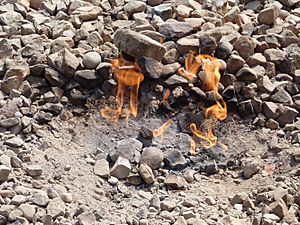Natural gas facts for kids

Natural gas is a type of mixture found deep underground. It is mostly made of hydrocarbons, with the main part being methane. You can find natural gas by itself or sometimes mixed with petroleum (oil). Even landfills and some natural processes create small amounts of methane. We usually move natural gas to homes and businesses using pipelines.
Most natural gas is burned as a fuel to create energy. When it burns, it makes a clean blue flame and causes very little pollution. Natural gas is used to make electricity, to cook food, and to heat buildings. It can also power natural gas vehicles. In a power station, burning natural gas heats water to make steam. This steam spins a steam turbine, which then turns a generator to produce electricity. Some power stations use natural gas directly in a gas turbine.
Natural gas is also changed into many different industrial chemicals. It is the main source for making pure hydrogen. Hydrogen is used in fuel cells and to create ammonia. Ammonia is used as a fuel, a fertilizer for crops, and to make many other products. Natural gas can also be turned into monomers, which are used to make many kinds of plastic items.
Contents
History of Natural Gas Use

People first found natural gas by accident in ancient China. This happened around 500 BC (or maybe even 1000 BC) when they were drilling for salty water. The Chinese found a way to move the gas that was leaking from the ground. They used simple pipelines made of bamboo. This gas was then used to boil salty water to get salt in the Ziliujing District of Sichuan.
In the Americas, natural gas was discovered and identified in 1626. Later, in 1821, William Hart successfully dug the first natural gas well in Fredonia, New York, United States. This led to the creation of the Fredonia Gas Light Company.
The city of Philadelphia started the first city-owned natural gas distribution system in 1836. By 2009, about 66,000 cubic kilometers of natural gas had been used. This was about 8% of the total estimated natural gas that could still be recovered. Experts thought there were about 850,000 cubic kilometers left.
Based on how much gas was used in 2015 (about 3,400 cubic kilometers per year), the remaining gas could last for 250 years. However, if people use 2-3% more gas each year, these reserves might only last for 80 to 100 years.
How We Use Natural Gas
Generating Electricity with Natural Gas
Natural gas is a main source for making electricity. This happens by using gas turbines and steam turbines. Many power plants that provide extra electricity during peak times use natural gas. Some smaller, off-grid generators also use it.
We can get very high efficiency by combining gas turbines with a steam turbine. This is called a combined cycle system. Natural gas burns more cleanly than other fossil fuels like oil and coal. It also produces less carbon dioxide for the same amount of energy.
For the same amount of heat, burning natural gas creates about 30% less carbon dioxide than burning petroleum. It creates about 45% less than burning coal. This makes combined cycle power generation using natural gas the cleanest way to make power using fossil fuels. This technology is used widely where gas is affordable.
Using Natural Gas at Home
Natural gas is sent to homes for many uses. It powers natural gas stoves and ovens for cooking. It can also heat clothes dryers. Many homes use it for heating and cooling systems, as well as for central heating. This includes boilers, furnaces, and water heaters.
In rural homes that are not connected to pipes from public gas services, CNG can be used. It is also used for portable grills. However, LPG (propane) is more common in rural areas because it is often cheaper than CNG.

Natural Gas for Transportation
Compressed natural gas (which is mostly methane) is an alternative fuel for cars. It can be used instead of gasoline (petrol) and diesel. In 2008, there were 9.6 million natural gas vehicles around the world. The countries with the most were Pakistan (2.0 million), Argentina (1.7 million), Brazil (1.6 million), Iran (1.0 million), and India (650,000).
Natural gas engines are generally as efficient as gasoline engines. However, they are less efficient than modern diesel engines. Cars that are changed from gasoline to natural gas might lose some power (10%-15%). This is because their engines have a low compression ratio. But engines made specifically for CNG use a higher compression ratio. This is because natural gas has a higher octane number of 120–130.
Natural Gas in Fertilizers
Natural gas is a main material used to make ammonia. This happens through a process called the Haber process. Ammonia is then used to produce fertilizers for growing crops.
Natural Gas for Hydrogen Production
Natural gas can be used to create hydrogen. One common way to do this is with a hydrogen reformer. Hydrogen has many uses. It is a key material for the chemical industry. It helps in processes like hydrogenation and is important for oil refineries. Hydrogen is also a fuel source for hydrogen vehicles.
Other Uses of Natural Gas
Natural gas is also used to make many other products. These include fabrics, glass, steel, plastics, and paint.
Related pages
Images for kids
-
Polyethylene plastic main being placed in a trench
See also
 In Spanish: Gas natural para niños
In Spanish: Gas natural para niños










